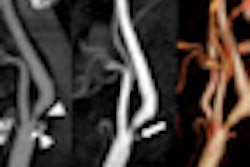
NEW YORK (Reuters Health) - Multidetector CT (MDCT) is highly sensitive and specific for identifying cardiac and arterial sources of ischemic stroke, according to a report online November 9 and in the January issue of Radiology.
"Our results suggest that multidetector CT could become the first-line imaging tool for identifying the cause of acute ischemic stroke," Dr. Loic Boussel from Louis Pradel Hospital in Bron, France, said in a news release announcing publication of the report.
Dr. Boussel and colleagues compared findings of a single-session MDCT protocol with established imaging methods for the etiologic workup of acute ischemic stroke in a single-center, prospective open pilot study of 46 patients.
The protocol included imaging of vessels in the heart, aortic arch, and extra- and intracranial arteries.
The mean radiation dose to the patients was fairly high, at 20.8 mSv, equal to 1040 chest x-rays or about 6.8 years of exposure to natural background radiation.
The procedure also required two intravenous contrast material injections to study the chest and neck area.
Based on comparisons with transthoracic echocardiography (TTE) and transesophageal echocardiography (TEE), MDCT was 72% sensitive and 95% specific for identifying cardiac sources of emboli.
Similarly, based on findings from ultrasound and MR angiography, MDCT was 100% sensitive and 91% specific for detecting major arterial atheroma.
Overall, MDCT correctly classified the stroke cause for 38 of the 46 patients (83%).
"CT allows a fast diagnosis and helps to identify the cause of the stroke during a single examination," Dr. Boussel said in the news release. "Moreover, because it is quick, the exam is well-tolerated, which is critical in acute stroke patients who may be unstable and agitated."
"Negative MDCT results should be confirmed with TEE and MR imaging," the researchers advise. "This imaging strategy should be validated in a larger randomized study involving medical-economic analysis to prove its cost-effectiveness in the etiologic workup of ischemic stroke."
Source: http://link.reuters.com/zyb64q
Radiology 2011.
Last Updated: 2010-11-09 14:06:24 -0400 (Reuters Health)
Related Reading
CAD algorithm spots acute intracranial hemorrhage, September 20, 2010
Study finds diffusion-weighted MRI tops CT in diagnosing stroke, July 12, 2010
Volume helical shuttle CT perfusion identifies stroke patients, April 20, 2010
Resting fMRI exam may predict stroke and brain injury outcomes, March 30, 2010
MRI links silent stroke to kidney failure in diabetics, February 1, 2010
Copyright © 2010 Reuters Limited. All rights reserved. Republication or redistribution of Reuters content, including by framing or similar means, is expressly prohibited without the prior written consent of Reuters. Reuters shall not be liable for any errors or delays in the content, or for any actions taken in reliance thereon. Reuters and the Reuters sphere logo are registered trademarks and trademarks of the Reuters group of companies around the world.


















